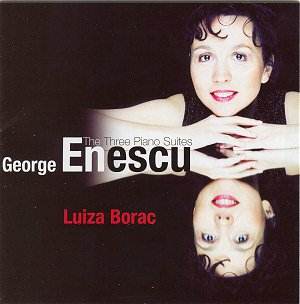Enescuís
three Piano Suites chart the development of this most protean
of composers from 1897, his sixteenth year, to 1916. Whilst only
the last of them gives a foretaste of the mature Enescu of the
opera Oedip or the Piano Sonatas, all this music is imaginative,
vital and idiomatic Ė something only to be expected from this
most remarkable of musical polymaths, the composer-violinist-conductor
whose own piano technique was the envy of Alfred Cortot, no less!
Just
now Luiza Boracís Avie account has the field more or less to itself.
Aurora Ienei on Olympia is theoretically available but difficult
to obtain. Cristian Petrescuís, from his controversial but charismatic
3-CD set of the complete piano music on Accord, has been unaccountably
deleted; the Second Suite is certainly available in mixed
recitals by Monica Gutman (Claves) and Daniel Goiti (Symposium)
but neither of these is specially worth seeking out. Even the
composerís own recording of a handful of movements from the first
two suites has, with the demise of Dante-Lys, gone temporarily
underground.
Fortunately,
Boracís attractively produced CD is more than just a stopgap,
enhanced as it is by Martin Andersonís notes and a neat essay
on the technical difficulties of the Suites from the pianist herself.
If what Anderson aptly describes as the "crazy Bachian quality"
of the First Suite dans le style ancien is rendered
a touch somnolently, there is clarity in both playing and recording
to compensate. The disconcertingly bland Adagio is the
only movement where Borac stumbles, failing to catch its enigmatic,
deadpan quality. Here we certainly miss Ieneiís poise, compromised
though that was by Olympiaís tinny recording.
In
the more Frenchified neo-classical games of the Second Suite,
Borac treads equally cautious ground. Though the majestic opening
Toccata lacks nothing in grandeur thereís a hint of prissiness
about her over-pointed articulation. The wistfulness of the elegant
Pavane is brought out well, though partially at the expense
of that bercé (rocking) rhythm Enescu asks for and
captured in his own, more flowing version.
The
Pièces impromptues are not an integrated suite but
a collection of independent compositions written between 1913
and 1916. They inhabit a different sound world altogether, more
complex and personal, shot through the Slavic richness associated
with Enescuís later music. Most substantial are the linked Choral
and Carillon nocturne which close the suite, fading to
the sound of church bells echoing enharmonically through the Romanian
summer night. A magical effect, precisely evoked by Borac. The
reflective element in many of the Pièces suits the
personality of her playing well, though once again in faster movements
such as the Mazurk mélancholique (not enough Mazurka
and too much melancholia) rhythmic elasticity can be lacking.
This
is absorbing music, outstandingly recorded. If Luiza Borac does
not always rise to some of the insights of some of her earlier
Romanian compatriots, her interpretations are consistently lucid
and thoughtful. Especially given the absence of competition, this
is a self-recommending, quality issue.
Christopher
Webber
see
also review by Kevin
Sutton and Rob
Barnett
